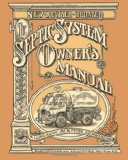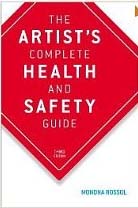Dyeing safety for the environment: which dye would you recommend for a septic system?
Name: Jenny
—ADVERTISEMENTS—

The Septic System
Owner's Manual

Environmental Aspects
of Textile Dyeing
edited by R. M. Christie

Biodegradation of Azo Dyes (The Handbook of Environmental Chemistry)
edited by H. A. Erkurt

Phytoremediation Technologies for the Removal of Textile Dyes
by S P Govindwar and A N Kagalkar

The Artist's Complete Health and Safety Guide
by Monona Rossol
Country or region: Minnesota
Message: Wow, just found your site and have been reading all afternoon! I live in a rural area and don't have access to a city sewage treatment system. What I discharge into my septic tank should be non-toxic and OK to get into ground water. It seems that everyone talks about dyeing safety for the dyer but not for the environment. Other than vegetable dyes with safe mordants, what would you recommend to color/dye cellulose fibers? The MSDS sheets I've checked all state something like "Dispose in a safe manner." Not very helpful. If you are able to comment on this topic please address both dyes and mordants. THANKS SO MUCH!
MSDS pages can be surprisingly variable. Some contain much more information than others, although they concern the same chemical. It's good to look at MSDS pages from different sources to see if they contain more information. Our dye suppliers have some information on the topic of safe disposal in septic tanks, too: see PRO Chemical & Dye's Studio Safety Guidelines, and Dharma Trading Company's Fiber Reactive Dye General Information page.
If you have a sufficient water supply to do the necessary washing-out after dyeing, I recommend fiber reactive dyes for cellulose, because they do not require toxic mordants, only the same soda ash that is found in most laundry detergent powders. If you use tie-dyeing or other forms of direct dye application such as dye painting, you can also avoid the use of salt. Procion MX dyes are an excellent choice. Some other fiber reactive dyes, while more expensive for the hand dyer, do not require quite as much water for washing out, and thus may be more environmentally appropriate during a drought. In the US, Remazol fiber reactive dyes can be ordered from PRO Chemical & Dye as their Liquid Reactive Dyes, and from Dharma Trading Company and other Jacquard Products retailers as Vinyl Sulphon dyes. Drimarene K dyes are also supposed to require less water for wash-out, but they are harder to obtain at good prices in the US; Dylon Permanent Dye and (I think) Tulip Permanent Dye are mostly composed of Drimarene K dyes, but both are packaged to be considerably more expensive than Procion dyes, and the color choices provided by Dylon are not very suitable for mixing your own colors. I find natural dyes to be an aesthetically appealing idea, but there are reasons (detailed in some of the links at the end of this post) why their use is often not as environmentally friendly as you might imagine. I recommend against all-purpose dyes because they represent the worst of both worlds, wearing off so quickly that they encourage disposable clothing; they also require large quantities of salt. Sometimes fabric paints are recommended by their sellers as a substitute for dyes, because of their supposed environmentally friendly aspects, but in fact only the reduced requirement for washing-out water is significant; I suggest using them in place of dyes only when you are in an extreme water shortage situation, or for special effects.
The main issues in disposing of relatively non-toxic dyes, such as Procion or Remazol or Drimarene dyes, are the amount of salt you dispose of, and the amount of water you use. While some of these dyes contain small amounts of copper or other metals, the quantities involved are small enough not to be considered an issue. However, salt in excess is bad for the microbes in a septic system, and excessive water throughput may exceed the capacity built in to a particular septic system. You will need to calculate how many gallons a day you will be disposing of as the result of your dyeing, not only in dyebaths, but particularly from washing out excess dye, as well, and compare this to the capacity your septic system is rated for. Overwhelming your septic system with more water than it was built for can cause serious problems for it. Everything depends on how much dyeing you are doing.
Disposing of a large amount of high-pH (basic) or low-pH (acidic) dyebaths can also be bad for the microbes in a septic system, since microbes cannot live in a place where the pH is much above or below normal limits, but it's easy to neutralize the pH before disposal by adding acid to a basic dyebath (one containing lye or soda ash), or by adding a high-pH chemical to an acidic dyebath. Dilution with other household wastewater makes small quantities less of an issue.
Mordants are a more serious issue than most dyes. While safe tannic acid is used along with alum as a mordant for natural dyes on cellulose fibers, all other mordants are metal ions. (Vinegar, tartaric acid, soda ash, and other pH modifiers are not mordants at all, because they do not form a permanent part of the dye-fiber bond, though sometimes people who don't fully understand dyeing describe them as such.) Many natural-dye dyers feel that it is responsible to stick to only tannic acid, alum, and possibly iron mordants, avoiding the use of chrome, tin, and copper mordants altogether.
Alum is considered the safest of all the metal ion mordants. It is not a problem when washed down the drain; in fact, alum is an important substance for water purification. However, do not let this relax you into not worrying about its toxicity. There have been fatalities caused by ingestion of alum, involving 30 grams for an adult; much smaller quantities can be fatal to a child, and much smaller quantities still may cause illness, if alum is swallowed. Perhaps from an excess of caution, I do not use alum-mordanted fabric anywhere that a child or pet is likely to chew on it. It is safer to use Procion dyes for baby clothes, slings, or bedding than it is to use natural dyes that are mordanted with alum. Tannic acid is not good to eat, either, as it can cause stomach upset, but dangerous quantities taste horribly bitter, so I think it is unlikely to be a problem as long as your supplies are kept out of the reach of children.
Tin mordant (stannous chloride) and copper mordant (copper sulphate) can each be very toxic to a careless user or to children or pets who gain unsupervised access to them. Fisher Scientific provides an MSDS for stannous chloride that says, "Do not let this chemical enter the environment." The MSDS that Fisher Scientific supplies for copper sulfate specifies, "Avoid runoff into storm sewers and ditches which lead to waterways. US regulations require reporting spills and releases to soil, water, and air in excess of reportable quantities." Another MSDS for copper sulfate, from Phelps Dodge Corporation has such alarming warnings as "may result in irreversible eye damage" and mentions that the reportable quantity is 10 pounds or more. I suspect that if you use copper sulfate in hand dyeing, you would use far less than this amount, but the Clean Water Act calls for waterways to contain less than 0.0056 milligrams per liter, on average.
Although iron sulfate is highly toxic in overdose and can easily kill a child who swallows too many iron pills, it is considered much safer to work with and dispose of than tin or copper. The average fatal dose is 200 to 250 milligrams per kilogram of body weight; for a fifty-pound child, this works out to less than five grams.
It is most important to avoid ever using chrome (potassium dichromate) as a mordant, because it is not only a known human carcinogen, it is also damaging to the environment. If you look at an MSDS for potassium dischromate, you will see that it is much more alarming than any of the other substances I've mentioned. It must be disposed of as a hazardous waste. I recommend against any hand dyeing that involves chrome.
However, the small amounts of chromium in metal complex dyes (also known as premetallized acid dyes) are a different matter, because they are in the much safer trivalent form, rather than the highly dangerous hexavalent form of potassium dichromate. They are also present in far smaller amounts. You should never dispose of your chrome mordant baths into your septic system or a city sewer, but it is okay to dispose of small quantities of chromium-containing metal complex acid dyes such as Lanaset Jet Black down the drain, if they are well-diluted.
Here are links to some other web pages and dyeblog posts in which I have further explored environmental considerations for dyes and mordants:
(Please help support this web site. Thank you.)
Posted: Friday - July 20, 2012 at 12:11 PM
Follow this blog on twitter here.
Quick Links
- All About Dyes & Dyeing Top -
- Top of this blog -
- FAQ -
- The Dye Forum -
- How to Tie Dye - How to Batik -
- Books - Toys - Plants -
- Top of this blog -
- FAQ -
- The Dye Forum -
- How to Tie Dye - How to Batik -
- Books - Toys - Plants -
More in this category:
- -
Statistics
Total entries in this blog:
Total entries in this category:
Published On: Aug 29, 2012 02:49 PM
Total entries in this category:
Published On: Aug 29, 2012 02:49 PM